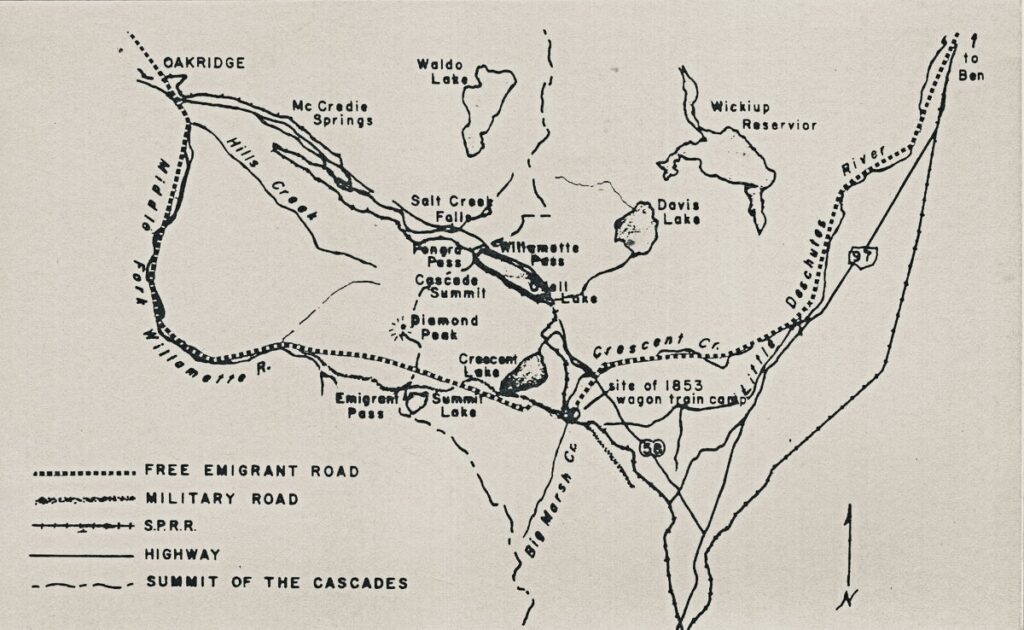The Wagon Train of 1853 left Fort Boise and split from the Oregon Trail near Vale, Oregon. Approximately 1,000 people and 250 wagons followed Elijah Elliott on a new and reportedly much shorter route to the southern Willamette Valley. After a grueling journey across the Oregon desert, they camped near Bend along the Deschutes River and sent scouts ahead. Fresh blazes were happily reported near La Pine. The wagon train then turned up the eastern slope of the Cascades toward their sought-after landmark—the snow-capped Diamond Peak. By early October, storms had already begun. Though traveling through snow was greatly feared, they forged desperately ahead toward their destination, the Willamette Valley.
 The trail-weary men and women endured extreme difficulties as they made their way south of Diamond Peak, through the dense forests and rugged bluffs of the high Cascades. Heavy timber and fallen trees created near-impossible obstacles. With hand axes, the men chopped deep notches in massive fallen trees while women and children helped by carrying limbs, rocks, and dirt to build a path over the obstructions. It was backbreaking work. Some days, they advanced less than a mile. Wagons with broken wheels continued with a skid jury-rigged under one axle. Many other wagons broke down completely and were abandoned. Teams of horses and oxen perished from lack of forage and exhaustion.
The trail-weary men and women endured extreme difficulties as they made their way south of Diamond Peak, through the dense forests and rugged bluffs of the high Cascades. Heavy timber and fallen trees created near-impossible obstacles. With hand axes, the men chopped deep notches in massive fallen trees while women and children helped by carrying limbs, rocks, and dirt to build a path over the obstructions. It was backbreaking work. Some days, they advanced less than a mile. Wagons with broken wheels continued with a skid jury-rigged under one axle. Many other wagons broke down completely and were abandoned. Teams of horses and oxen perished from lack of forage and exhaustion.
Hunger was their constant companion after meager provisions ran out. Starvation was not a stranger. Colonel Cline, a member of the train, had retained a few head of cattle, hoping to rebuild a herd in Oregon. One by one, the cattle were slaughtered. Each animal yielded tough, stringy meat, and the cooking kettles held more bones than flesh. One of the starving men later recalled, “The meat was so tough I couldn’t stick a fork in the gravy.”
Their situation became increasingly desperate. A young schoolteacher, Martin Blanding, set off ahead to seek help. He followed the cuts made by the Free Emigrant Road builders down into the valley. Some settlers found him at his campfire along the Willamette River. Word of the wagon train’s dire plight quickly spread.
Emergency provisions were gathered by settlers, loaded onto packhorses, and rushed upriver to the starving emigrants.

Several early settlers from the valley assisted with the rescue. Cornelius J. Hills, grandfather of Lawrence D. Hills (a past mayor of Oakridge), was part of this mercy mission. He often said he had never made flapjacks so fast in his life.
One small boy, tears streaming down his face, clutched his first flapjack. When asked why he didn’t eat it, he replied, “I can’t. I’m afraid I’ll never get another one.”
Another man ate ravenously, and when rescuers tried to slow him down for fear of overindulgence, he said, “I have been hungry for so long—if I die, I want it to be with a full stomach.”
With emergency food to sustain them, the emigrants regrouped, leaving behind a trail of broken wagons and discarded household items. Even their precious and indispensable Dutch ovens were sacrificed due to their weight. Yet their hardships were far from over.
Near Boulder Grade, as a wagon attempted to descend a steep bank, Mrs. Joseph Petty (Nancy Prosser) was fatally injured when a heavy trunk shifted and crushed her. Some accounts place this accident at other locations, such as Simpson Creek, Crowbar Point, or Black Canyon. She had a newborn infant who died a few months later. Mrs. Petty was buried along the river, where a white picket fence once marked her grave. It remained for several years before spring floods on the Willamette washed it away.
Rescuers from the valley hurried the newcomers down from the mountains and helped them set up winter camp in abandoned cabins as late fall storms intensified.
Many families from this determined group persevered, established homes, and became prominent in shaping the affairs of their new land—hard-won through so much sacrifice and hardship.

This historical marker, designed and donated by woodcarving artist Art Clough, was dedicated in 1950 during the final Pioneer Pageant in Eugene. Cal Young, a pioneer, was the speaker for the occasion.
The memorial was originally located above Rigdon Ranch, south of Crescent Lake, along the route of the Free Emigrant Road. It was later moved to its present location in Greenwaters Park, Oakridge, where emigrants forded the Willamette River on their journey. From this point to Eugene City, they followed the riverbed, crossing back and forth some 27 times over riffles and boulders.

 Behind every route is scouting, mapping, storytelling, and a whole lot of pedal power.
Behind every route is scouting, mapping, storytelling, and a whole lot of pedal power.